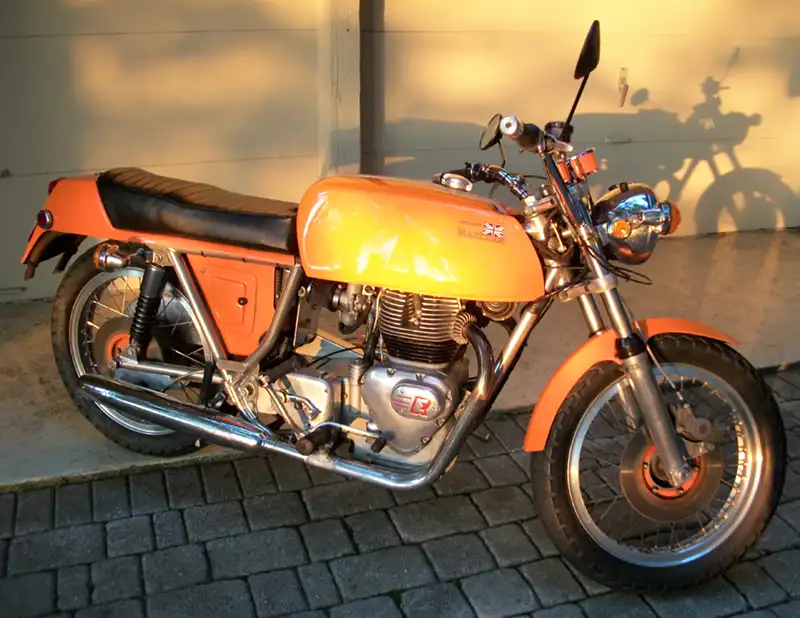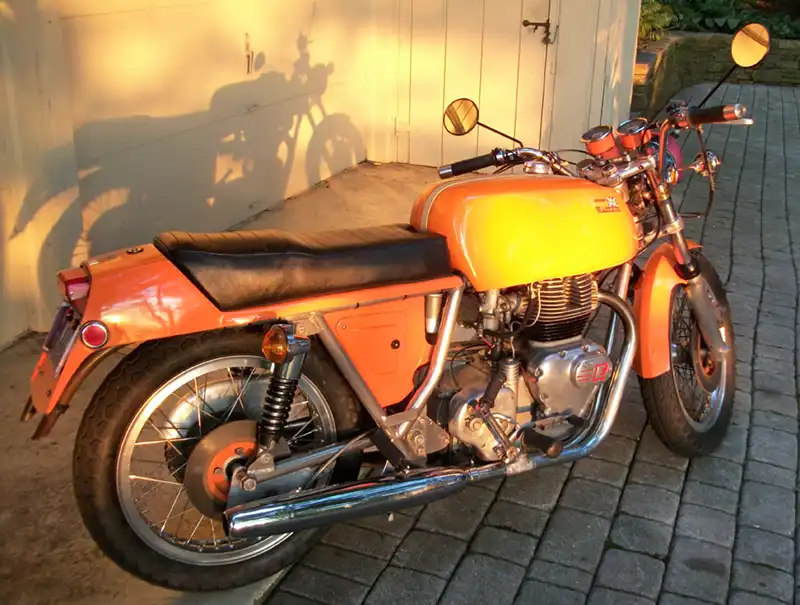 A few years ago, I was on the prowl for another English bike, since the Italians in my garage were beginning to outnumber the Brits, and I like to maintain a balance of power.
A few years ago, I was on the prowl for another English bike, since the Italians in my garage were beginning to outnumber the Brits, and I like to maintain a balance of power.
Royal Enfield’s factory in Redditch was located, oddly, underground in an old coal mine. It closed in 1969, with a pile of leftover tooling and about 200 unused engine assemblies. At the time, the Rickman brothers were producing beautiful nickel-plated chrome-moly duplex frames and front forks, normally paired with Girling shocks and fiberglass body work par excellence, all hand-formed by gifted craftsmen. Back in the day, a Rickman Metisse (French for “mongrel bitch”) was a force to be reckoned with on European MX tracks. The Rickmans purchased the surplus Enfield engines, and paired them with a new rolling chassis based on their proven formula to create around 175 street bikes. I remember dreaming about the awesome Rickman Royal Enfield (R2E) big twin, the first production bike with front and rear disc brakes, in 1970.
Thirty years later, I began making inquiries, eventually leading to a fellow with two Rickman Royal Enfields up and running, plus a whole bunch of loose parts. Long story short, I shipped him a pile of money, he shipped me a palette and 6 or 8 huge boxes containing most of a motorcycle, along with reassurances that he would follow up with anything that might be missing.
This was one very involved puzzle. I had an Enfield manual which covered the engine, but had to rely on pictures, old magazine articles and the advice of others to create a complete stock motorcycle. The seller made good on his promise to ship some additional parts, but many others had to be sourced elsewhere, and still more had to be fabricated. In the end though, several months of intense labor and creative effort got me my Rickman Royal Enfield.
The resulting machine is unique and enjoyable enough to justify its process of creation. The engine’s long-stroke layout features separate cylinders and heads perched atop a vertically split crankcase. The oil reservoir is in an isolated cast-in compartment, and the primitive Albion gearbox bolts to the back of the crankcase rigidly, for a sort of semi-unit construction. The foot pegs are actually mounted with welds onto the header pipes! A handsome bread-loaf-shaped fuel tank and sporty seat, tail section, fenders and air box are all Rickman-manufactured, as are the unusual handlebars. Although the bars clip onto the fork tubes, they reach way up and back, producing an upright, feet-forward riding position. Weird, but hey, it’s British. Besides, the damn thing works.
 Riding it is exciting, with the all-up weight of 375 pounds being lunged forward by the torquey motor. The suspension is firm but top-notch, and steering is impeccable. The frame is gorgeous, with nickel plating and perfect hand-formed gas welds, but its real beauty lies in the way this thing handles. Lockheed brakes haul everything down RIGHT NOW, with terrific feel and sensitivity. Alloy rims carrying Dunlop K81’s help keep things planted. The engine dominates with its big, thudding power curve. Even with handlebar end weights to quell vibration, a few hours in the saddle will still let you know how a real man feels on a real machine. As with any vintage machine, this project is ongoing, with current goals of reducing oil usage. While the beast is being slowly dragged into the 21 st century, further development demands test mileage. Let’s find a long curvy road, and open up the throttle.
Riding it is exciting, with the all-up weight of 375 pounds being lunged forward by the torquey motor. The suspension is firm but top-notch, and steering is impeccable. The frame is gorgeous, with nickel plating and perfect hand-formed gas welds, but its real beauty lies in the way this thing handles. Lockheed brakes haul everything down RIGHT NOW, with terrific feel and sensitivity. Alloy rims carrying Dunlop K81’s help keep things planted. The engine dominates with its big, thudding power curve. Even with handlebar end weights to quell vibration, a few hours in the saddle will still let you know how a real man feels on a real machine. As with any vintage machine, this project is ongoing, with current goals of reducing oil usage. While the beast is being slowly dragged into the 21 st century, further development demands test mileage. Let’s find a long curvy road, and open up the throttle.

